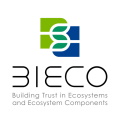Domain Specific Language
Coordinated by
IESE
The domain specific language enables specification of digital twin behaviour in a manner that can enable a predicted evaluation of its trustworthy behaviour in a simulated environment
Description
Describe the innovation content of the result:
Aiming at a runtime predictive evaluation of trust in an ecosystem component, the language enables specification of the DT behavior in accordance with this innovative methodology.
Who will be the customer?
The customers are researchers in the first stage. In the long term, practitioners from industry that want to employ the mechanism of predictive simulation for building trust in ecosystem components.
What benefit will it bring to the customers?
Guides the specification of specialized models that can become digital twins when fed with real-time data. When executed in a predictive manners, these digital twins enable an evidence-based computation of trust performed in a virtual environment. When performed at runtime, it is envisioned to enable the timely triggering of the safe fail-over behavior.
When is the expected date of achievement in the project (Mth/yr)?
Methodology concept in 08/2022, Domain Specific Language 08/2023
When is the time to market (Mth/yr)?
Further development of the language is required. In about 5 years, 08/2028
What are the costs to be incurred after the project and before exploitation?
The first version of DSL will be ready for use at the end of BIECO but further research based on it will need to be framed on other innovation projects.
Within the following years, when appropriate research funding will be directed towards evolving the language with more specialized rules
What is the approximate price range of this result/price of licences?
Open source
What are the market size in Millions € for this result and relevant trend?
N/A
How will this result rank against competing products in terms of price/performance?
The DSL addresses some of the major challenges identified among the competitor schemes for addressing uncertainties of self-adaptive systems part of evolving digital ecosystems
Who are the competitors for this result?
National and international public and proprietary evaluators that implement a runtime simulation-based approach for assuring the safety of self-adaptive systems.
How fast and in what ways will the competition respond to this result?
Creation of a similar solution will take at least three years.
Who are the partners involved in the result?
In the concept of the methodology no partnership has been foreseen. However, a particular instantiation of the methodology will be provided with the support of RES .
Who are the industrial partners interested in the result (partners, sponsors, etc.)?
RESILTECH, TTTech
Have you protected or will you protect this result? How? When?
Research publications are provided along the way of the concept development and its validation.
Other results
BIECO Integrated Platform
BIECO Integrated Platform will integrate the tools in a loosely coupled way.
Data Collection Tool
Data Collection Tool (DCT) stores information from relevant vulnerability related datasets, providing a single access point to information required by the vulnerability detection and forecasting tools developed in T3.3, as well as for the failure prediction tools developed in T4.2.
Vulnerability Detection Tool
Vulnerability Detection Tool will detect existing vulnerabilities within the source code which may lead to the successful execution of an attack.
Vulnerability Exploitability Forecasting Tool
Vulnerability Exploitability Forecasting Tool will estimate the probability of a vulnerability to be exploited in the next 3, 6 or 12 months.
Vulnerability Propagation Tool
Vulnerability Propagation Tool will calculate and offer the paths affected by a vulnerability in the source code.
Fuzzing Tool
Fuzzing Tool will test System Under Test (SUT) security vulnerabilities or inputs not contemplated that could compromise the system; as a black-box process, by using unintended or incorrect inputs and monitoring their corresponding outputs.

